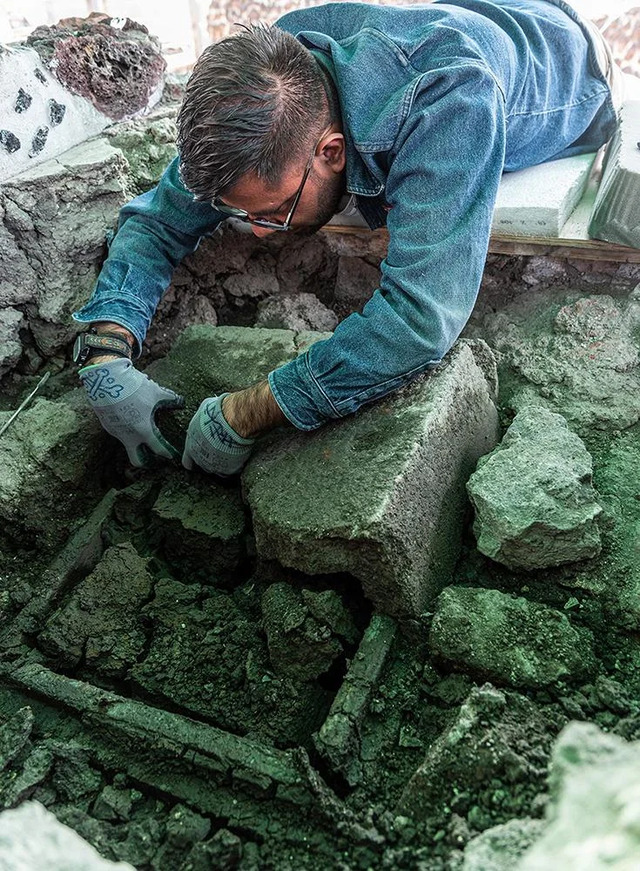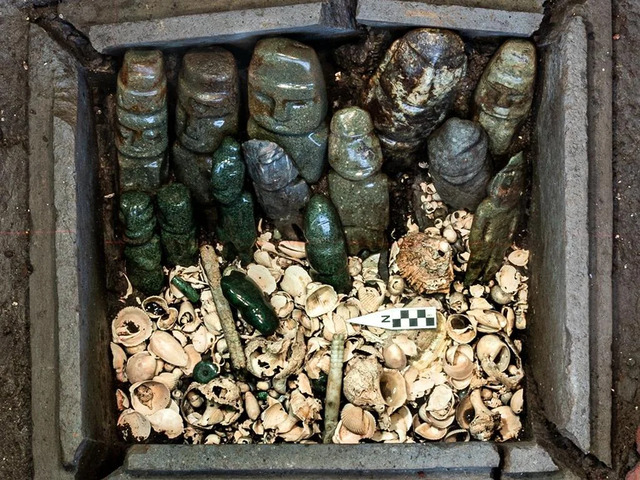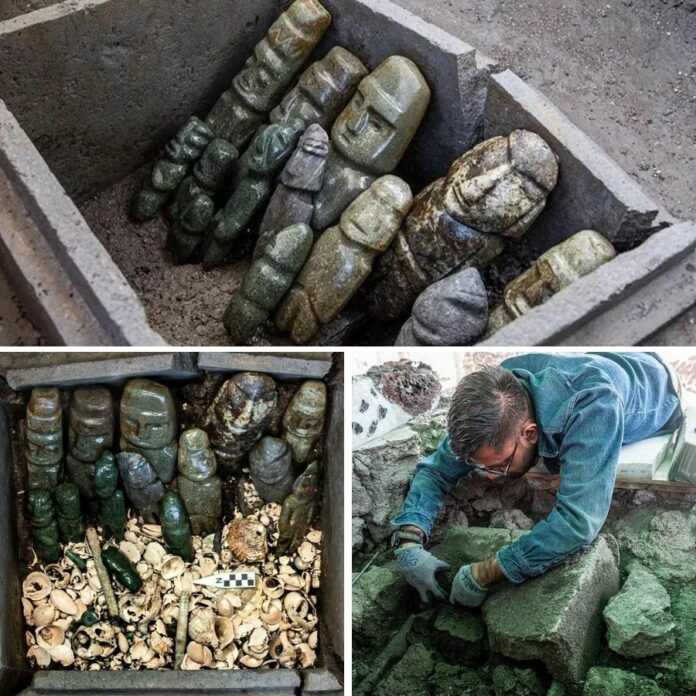The Templo Mayor, nestled at the heart of the ancient Aztec capital of Tenochtitlan, remains a symbol of the empire’s rich cultural and spiritual heritage. Recent excavations at this iconic site have unearthed a significant find—a stone chest, or tepetlacalli, containing 15 anthropomorphic figurines alongside an array of ritual artifacts. This discovery offers a glimpse into the Aztecs’ religious practices and their reverence for symbolism, shedding light on the complex cultural exchanges that defined their empire.
The Templo Mayor: A Centerpiece of Aztec Civilization
Dedicated to the gods Huitzilopochtli, the deity of war, and Tlaloc, the god of rain and agriculture, the Templo Mayor stood as the spiritual and political heart of Tenochtitlan. Built after 1325, the temple complex reflected the duality of Aztec religion and its connection to both conquest and sustenance. The structure, however, met its demise in 1521 with the Spanish conquest, leaving behind remnants of its grandeur buried beneath modern Mexico City.
As the epicenter of Aztec religious ceremonies, the Templo Mayor was a hub for rituals, offerings, and sacrifices. Each layer of the temple’s construction symbolized the empire’s expansion and dedication to the gods. The recent discovery of Offering 186 underlines the temple’s role as a sacred repository, where the Aztecs placed objects of profound symbolic and spiritual significance.
The Discovery: Offering 186
Archaeologists from the Templo Mayor Project and the National Institute of Anthropology and History (INAH) recently uncovered a meticulously crafted stone chest beneath the temple’s rear façade. This chest, now known as Offering 186, contained 15 anthropomorphic figurines carved from green metamorphic stones, along with a trove of other ritual artifacts.
The figurines, ranging from nearly a foot in height to just an inch tall, exhibit the distinctive Mezcala style. Among the figures, 14 represent male forms, while one depicts a miniature female. Notably, traces of facial paint on one figurine suggest its representation of Tlaloc, the Mexica god of rain. The chest also held rattlesnake-shaped earrings, 135 greenstone beads, and an astonishing collection of nearly 2,000 seashells, snail shells, and pieces of coral. These marine artifacts, sourced from the Atlantic coast, reflect the Aztecs’ vast trade networks and their domination as part of the Triple Alliance.


Mezcala Art: A Window into Cultural Exchange
The figurines’ Mezcala style reveals the deep connections between the Aztecs and the earlier Mezcala culture, which thrived in northern Guerrero from 700 BCE to 650 CE. Known for its abstract geometric designs, Mezcala art embodies a unique aesthetic within Mesoamerican history. By the time of the Aztec Empire, many Mezcala sites were already over a millennium old, yet the Aztecs recognized the spiritual and historical value of these artifacts.
Under the reign of Emperor Moctezuma I (1440–1469 CE), the Aztecs actively sought out Mezcala relics, excavating ancient sites to incorporate these objects into their own religious practices. This act of cultural reclamation highlights the Aztecs’ respect for their predecessors and their ability to integrate older traditions into their evolving cosmology.

Symbolism in the Figurines and Artifacts
The items within Offering 186 collectively emphasize themes of water, fertility, and renewal—central tenets of Aztec spirituality. The greenstone figurines, often associated with life and fertility, were likely chosen for their symbolic resonance. Similarly, the presence of marine shells and coral signifies the importance of water in sustaining both the physical and spiritual realms.
One figurine’s traces of facial paint depicting Tlaloc underscore the Mexica’s devotion to the rain god, who was believed to control agricultural abundance. The chest itself, described by archaeologist Leonardo López Luján as a sacred repository, functioned much like the Aztecs’ household chests, where they stored their most prized possessions. However, these “stone cases” safeguarded items of immense spiritual importance, such as sacred sculptures, beads, and shells.

Broader Implications of the Discovery
The unearthing of Offering 186 provides invaluable insights into the Aztecs’ ritual practices and their sophisticated understanding of symbolism. Beyond its immediate religious significance, the discovery underscores the interconnectedness of Mesoamerican cultures. By incorporating Mezcala artifacts into their offerings, the Aztecs not only honored their ancestors but also reinforced their own spiritual identity.
This find also illuminates the Aztecs’ ability to adapt and assimilate elements from diverse cultural traditions. The careful placement of the figurines and other objects within the chest reflects a meticulous attention to ritual detail, emphasizing the importance of these practices in maintaining cosmic balance.
Conclusion
The discovery of anthropomorphic figurines at the Templo Mayor is a testament to the rich spiritual and cultural legacy of the Aztecs. Offering 186, with its meticulously crafted artifacts and profound symbolism, provides a window into the intricate rituals that defined this ancient civilization. As archaeologists continue to explore the depths of Tenochtitlan, such findings remind us of the enduring significance of the Templo Mayor as a beacon of Mesoamerican history and spirituality. Through these relics, we gain a deeper appreciation for the Aztecs’ reverence for the past and their unwavering connection to the divine.
